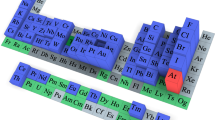Abstract
Metal ions are ubiquitous in the biosphere. In living organisms metalloproteins with specifically designed metal cores perform vital chemical processes. On the other hand, several heavy metals are detrimental to living organisms and nature has developed effective enzymatic detoxification systems which convert toxic metal ions to less toxic species. The nuclear spectroscopy technique Time Differential Perturbed Angular Correlation (TDPAC) of γ-rays uses radioactive isotopes as nuclear probes in these metal cores to obtain a better understanding of the structural and functional significance of these metal cores by monitoring the nuclear quadrupole interaction of the TDPAC probe. Since this technique is based on the nuclear decay, it is also applicable under physiological conditions, i.e., especially at picomolar concentrations. For these studies an indispensable prerequisite is the production of the TDPAC probes with highest possible specific activity and purity as is done by the on-line mass separator ISOLDE at CERN in Geneva.
Similar content being viewed by others
References
K. Miyazaki, M. Hasegawa, K. Funahashi and M. Uemeda, Nature 362 (1993) 839.
P. Umpathy, Coord. Chem. Rev. 95 (1989) 129.
S.J. Berners-Price and P.J. Sadler, in: Frontiers in Bioinorganic Chemistry, ed. A.V. Xavier (VCH, Weinheim, 1986) p. 376.
R.-D. Wilken and H. Hintelmann, Water Air Soil Poll. 56 (1991) 427.
R.C. Denney and R. Sinclair, Visible and Ultraviolet Spectroscopy (Wiley, Chichester, 1987).
H. Sigel, ed., Applications of NMR to Paramagnetic Species. Metal Ions in Biological Systems, Vol. 21 (Marcel Dekker, New York, 1986).
B.M. Hoffmann, Acc. Chem. Res. 24 (1991) 164.
E.I. Solomon and M.D. Lowery, Science 259 (1993) 1575.
C.D. Garner, Adv. Inorg. Chem. 36 (1991) 303.
P. Gütlich, R. Link and A. Trautwein, Mössbauer Spectroscopy and Transition Metal Chemistry (Springer, Berlin, 1978).
C. Keppler. K. Achterhold, A. Ostermann, U. van Bürck, W. Potzel, A.I. Chumakov, A.Q.R. Baron, R. Rüffer and F. Parak, EBJ 25 (1997) 221.
P. Mottner, T. Butz, A. Lerf, J. Erfkamp, K. Schneider and A. Müller, Biochim. Biophys. Acta 1164 (1993) 311.
A. Müller, W. Suer, C. Pohlmann, K. Schneider, W.G. Thies and H. Appel, European J. Biochem. 246 (1997) 311.
C. Pohlmann, A. Appel, W.-G. Thies, A. Müller, K. Schneider and W. Suer, Hyp. Interact. 59 (1993) 1575.
W. Tröger, T. Butz, E. Danielsen, R. Bauer, A. Messerschmidt, U. Thoenes, R. Huber, G.W. Canters and T. den Blaauwen, Hyp. Interact. 80 (1993) 1133.
E. Danielsen, R. Bauer, L. Hemmingsen, M.-L. Andersen, M.J. Bjerrum, T. Butz, W. Tröger, G.W. Canters, C.W.G. Hoitink, G. Karlsson, Ö. Hansson and A. Messerschmidt, J. Biolog. Chem. 270 (1995) 573.
E. Danielsen, R. Bauer, L. Hemmingsen, M.J. Bjerrum, T. Butz, W. Tröger, G.W. Canters, T. den Blaauwen and G. Pouderoyen, European J. Biochem. 233 (1995) 554.
W. Tröger, C. Lippert, T. Butz, K. Sigfridsson, Ö. Hansson, E. McLaughlin, R. Bauer, E. Danielsen, L. Hemmingsen, M.J. Bjerrum and the ISOLDE Collaboration, Z. Naturf. 51a (1996) 431.
T. Butz and W. Tröger, in: Bioinorganic Chemistry: Transition Metals in Biology and their Coordination Chemistry, ed. A.X. Trautwein (Wiley/VCH, New York, 1997) p. 302.
T. Butz and W. Tröger, in: Multi-Copper Oxidases, ed. A. Messerschmidt (World Scientific, Singapore, 1997) p. 431.
R. Bauer, Quart. Rev. Biophys. 18 (1985) 1.
L.G. Shpinkova, V.N. Kulakov, A.A. Sorokin, G.K. Ryasny, B.A. Komissarova and S.M. Nikitin, Z. Naturf. 53a (1998) 630.
W. Tröger, Hyp. Interact. 120/121 (1999) 117.
F.J. Schwab, H. Appel, M. Neu and W.-G. Thies, Hyp. Interact. 80 (1993) 1155.
H. Frauenfelder and R.M. Steffen, in: Alpha-, Beta-and Gamma-Ray Spectroscopy, Vol. 2, ed. K. Siegbahn (North-Holland, Amsterdam, 1965).
T. Butz, S. Saibene, Th. Fraenzke and M. Weber, Nucl. Instrum. Methods A 284 (1989) 417.
T. Butz, Z. Naturf. 51a (1996) 396.
T. Butz, M. Ceolín, P. Ganal, P. Schmidt, M.A. Taylor and W. Tröger, Phys. Scripta 54 (1996) 234.
G. Czjzek, Hyp. Interact. 14 (1983) 189.
I. Savini, L. Morpurgo and L. Avigliano, Biochem. Biophys. Res. Commun. 131 (1985) 1251.
K. Ando, J. Biochem. (Tokyo) 68 (1970) 501. [32] E.T. Adman, in: Metalloproteins, Part 1, ed. P. Harrison (Verlag Chemie, 1985).
B.L. Vallee and R.J.B. Williams, Proc. Nat. Acad. Sci. 59 (1968) 498.
A. Messerschmidt, R. Ladenstein, R. Huber, M. Bolognesi, L. Avigliano, R. Petruzelli, A. Rossi and A. Finazzi-Agró, J. Mol. Biol. 224 (1992) 179.
M.T. Graziani, L. Morpurgo, G. Rotilio and B. Mondoví, FEBS Lett. 70 (1976) 87. W. Tröger, T. Butz/Nuclear spectroscopy in inorganic biochemistry 527
L. Avigliano, A. Desideri, S. Urbanelli, B. Mondovíand A. Marchesini, FEBS Lett. 100 (1979) 318.
M.M. Morie-Bebel, M.C. Morris, J.L. Menzie and D.R. McMillin, J. Amer. Chem. Soc. 106 (1984) 3677.
A. Schmidt-Klemens, D.R. McMillin, H.-T. Tsang and J.E. Penner-Hahn, J. Amer. Chem. Soc. 111 (1989) 6398.
C. Lippert, Ph.D. Thesis, Leipzig (1996).
W. Tröger, Ph.D. Thesis, Physik-Department, Technische Universität München (1994).
T. Butz, W. Tröger, A. Messerschmidt, U. Thoenes and R. Huber, Hyp. Interact. 80 (1993) 1127.
S. Silver and T.K. Misra, Ann. Rev. Microbiol. 42 (1988) 717.
T. Butz, W. Tröger, Th. Pöhlmann and O. Nuyken, Z. Naturf. 47a (1992) 85.
C. Christou, K. Foltin and J.C. Huffman, Polyhedron 3 (1995) 1247.
W.N. Setzer, Y. Tang, G.J. Grant and D.G. van Derveer, Inorg. Chem. 30 (1991) 3652.
K.M. Comess, L.M. Shewchuck, K. Ivanetich and C.T. Walsh, Biochemistry 33 (1994) 4175.
L. Utschig, J.W. Bryson and T.V. O'Halloran, Science 268 (1995) 380.
F.H. Frimmel and R.F. Christman, eds., in: Humic Substances and Their Role in the Environment (Wiley, Chichester, 1988).
J.I. Kim, H. Wimmer, R. Klenze, Radiochim. Acta 54 (1991) 35.
C. Moulin, P. Decombox, P. Mouchien, V. Moulin and M. Theyssier, Radiochim. Acta 52/53 (1991) 119.
H. Kupsch, K. Franke, D. Degering, W. Tröger and T. Butz, Radiochim. Acta 7i3 (1996) 145.
W. Tröger, unpublished results.
Rights and permissions
About this article
Cite this article
Tröger, W., Butz, T. Inorganic biochemistry with short-lived radioisotopes as nuclear probes. Hyperfine Interactions 129, 511–527 (2000). https://doi.org/10.1023/A:1012646808055
Issue Date:
DOI: https://doi.org/10.1023/A:1012646808055




